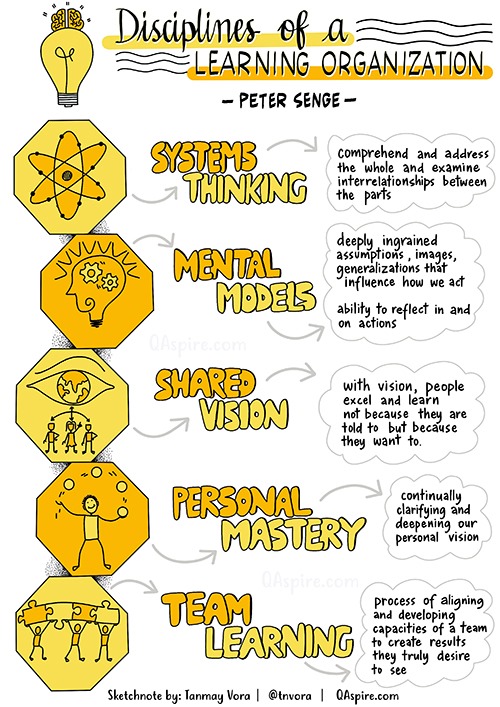5 Disciplines of a Learning Organization: Peter Senge
Tanmay Vora
In the face of rapid disruptions happening due to COVID19, organizations are required to rapidly respond to a constantly evolving context and realign themselves to the new realities.
This demands organizations, leaders and individuals to rapidly make sense of changing realities, understand patterns, clarify their purpose, align strategy to the purpose and mobilize people to execute on the strategy. New knowledge and understanding has to be translated into actions rapidly – which is at the heart of a learning organization.
In the last post, I shared updated sketchnote exploring the question, “Why Organization’s Don’t Learn?” Let’s explore the other important question, “How do organizations learn?”.
In his seminal book “The Fifth Discipline – The Art and Practice of Learning Organization”, Peter Senge presents five disciplines of a learning organization. They are:
Personal mastery is a discipline of continually clarifying and deepening our personal vision, of focusing our energies, of developing patience, and of seeing reality objectively.
Mental models are deeply ingrained assumptions, generalizations, or even pictures of images that influence how we understand the world and how we take action.
Building shared vision – a practice of unearthing shared pictures of the future that foster genuine commitment and enrollment rather than compliance.
Team learning starts with dialogue, the capacity of members of a team to suspend assumptions and enter into genuine thinking together.
Systems thinking – The Fifth Discipline that integrates the other four.
– Source: Wikipedia
In the book, Peter Senge offers a wonderful analogy to introduce systems thinking:
A cloud masses, the sky darkens, leaves twist upward, and we know that it will rain. We also know that after the storm, the runoff will feed into groundwater miles away, and the sky will grow clear by tomorrow. All of these events are distant in time and space, if they’re all connected within the same pattern. Each has an influence on the rest, and influence that is usually hidden from view. You can only understand the system of rainstorm by contemplating the whole not any part of the pattern.
Businesses and other human endeavors are also systems. They, too, are bound by invisible fabrics of interrelated actions, which often take years to fully play out their effects on each other. Since we are part of that lacework ourselves, it’s doubly hard to see the whole pattern of change. Instead we tend to focus on snapshots of isolated parts of the system, and wonder why our deepest problems never seem to get resolved.
While the book is a must-read for those interested in understanding deeper context behind these disciplines, here is a short sketchnote interpretation of 5 disciplines of a learning organization.
(You can see the original post and old sketchnote from 2015 here. This is a revised version of the sketchnote for better clarity)
[New] Raise The Bar: Pack of Sketchnotes on Leadership, Learning and Change
Having an attitude to lead and a mindset to learn are vital to thrive in a new world of work. The best leaders are relentless learners. This is a collection of 68+ powerful and actionable insights in form of hand drawn sketchnotes. These insights are packed with wisdom to help you raise the bar of leadership and learning for yourself, your teams and your organization. Do check it out.

